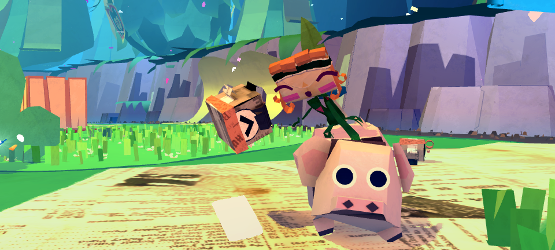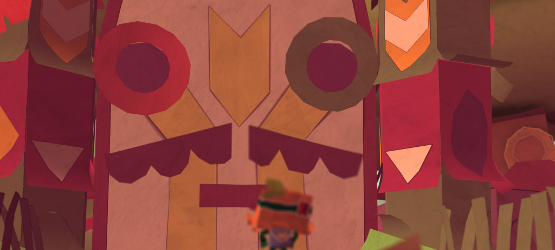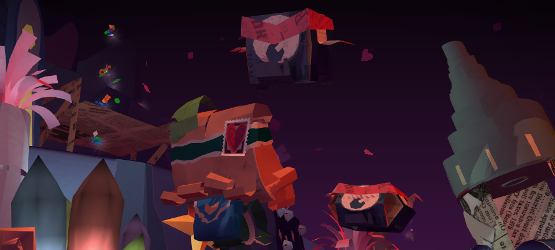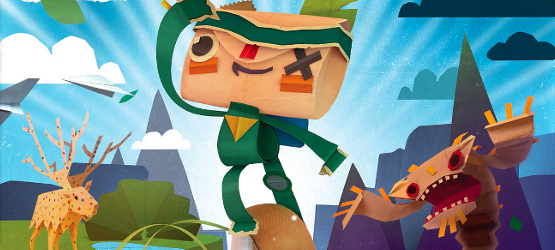Playing Tearaway is like folding a piece of paper in three parts and jumping from one part to another at odd intervals. Two of those parts are filled with intricate details, a fascinating use of narrative which includes the person actually playing the game, and one whole part is a bible on how to use the Vita to its fullest extent. The last part has some bad pointers on how to use the camera, what appear to be some glitches in the pulp of the paper, and some notes regarding an average platformer. Thankfully, the majority of the time with Tearaway is spent on the good parts of the paper.
Tearaway is a platformer in the vein of Media Molecule’s earlier LittleBigPlanet. Unlike the 2D running and jumping involved in LittleBigPlanet, Tearaway uses 3D worlds found in most post-PSOne platformers. Tearaway opens with the game’s two narrators happy to see you. Players are then greeted by, well, themselves. As stated above, Tearaway contains a bible on how to use the Vita’s hardware capabilities. Or rather, Tearaway is the bible. From the moment the Vita’s camera places your real-time face into the game to the final bits of moving platforms into place with the Vita’s motion sensors – Tearaway utilizes all of the Vita’s feature to their fullest and does so unabashedly and successfully. The use of the rear touchscreen to burst a finger into Tearaway’s world never feels forced. Sliding platforms into place becomes natural. Use of both cameras to find or unlock presents and confetti works both in and out of game. These features are all integrated into the game, and use of these features makes Tearaway’s world come alive.

Before players can get to the action, the game requests what struck as the friendliest gender and ethnicity survey ever to exist. This may feel out of place, but it is recommended to complete it with the closest approximation of how you see yourself. It really helps with the game’s integration of you as a character. Not only do players guide the in-game avatars of Iota or Atoi (whose names reflect a few puns – not only do they have meaning in regards to computer language, but a toi in French means “To You” and Iota is the Greek letter which forms the basis of “I”), playable letters made into characters by using some of the world’s paper; the players appear in the game as the sun. It is Iota or Atoi’s journey to deliver this message to You, the player. Players can manipulate the world by forcing their fingers through certain paper areas, tilting the “world” with their Vita, and other ways mentioned above.
Tearaway’s levels are entirely made from sheets of paper. It appears as if each piece is its own rendered object. It makes the locations players visit pop and allows for a lot of background and foreground pieces to move independently. The world-building of Tearaway is fantastic and it shows. However, due to the amount of objects on screen, there are a few instances where the game suffers from slowdown.
Tearaway rewards attention to detail like a good platformer. Carefully hidden pull tabs and good use of the camera hide away the game’s secrets and unlockables. Most of the time the camera can be freely adjusted to look around the environments – wherein each level is comprised of thousands of intricately placed pieces of paper – to collect all of the confetti, find all the presents and the photo opportunities the game offers. However, the flip side is that once camera control is taken away the game suffers. Bad angles hide the how wide a path is, fudge the jump angle on bounce pads, and generally become a nuisance. In a game like Tearaway, where the focus on freeing imagination is encouraged by the fact Tearaway is literally made of paper; you’d think the camera would be one of those freedoms.

The jump ability in Tearaway is discovered a few levels into the game. With it, Tearaway has its moments where it settles into an average platformer. The average part can make the Vita-driven platform elements really stand out, but also make the game a little dull when those parts are played. With the amount of stuff going on within the game there are a few glitches that pop up, typically when the game transitions to a cutscene. Three times little Atoi died without any reason. The most noticeable instance was a transition to a cutscene where she was snuffed out, causing a full minute of load time before the game finally realized how to process the need to get Atoi to a checkpoint, start the cutscene, and not lose anything in-between. Despite these deaths and that one minute of awkward silence, the pace of the game was kept up. This is because death is cheap. There are no lives to count, and often players start right next to or at the place their avatar died. There is also a checkpoint system in place.
Speaking of the avatars, the little guys are completely customizable. In addition to purchasing eyes, mouths, and other features or elements; players are able to bring up sheets of paper and draw new things on them. There does not seem to be a limit to anything, even size since items can be enlarged once brought off the cutting room table. Sheets can be stacked on top of each other for a multi-layered effect as well. All of these customizations carry over into the cutscenes. Finding myself in a large desert akin to a Wild West setting I decided to feather Atoi with little paper arrows. In a later cutscene, I saw each one of those little arrows shed from Atoi.
Tearaway’s greatest achievement is the ability to successfully bridge the disconnect between the gamer and the on-screen avatar. It’s not just the interaction a player is allowed to indulge in in Tearaway’s world, the customization of Iota or Atoi, or even the story of getting the letter to the player – it is also the way the game reaches out to the player. Tearaway often requests players to take a picture of their world with the camera and use it as a skin for a character or a background for a picture. Throughout the game, players can unlock papercraft models that players can make in the real world via the Tearaway.me website. Tearaway reaches out to players just as they reach in, and does a fantastic job both ways.

If there is one fault I found with this outcome, it is the game’s reliance on the player to achieve the connection between Tearaway and its players. I have no mind to spoil anything for players, but by the end of the game some players will be touched, others will cry, many will smile and still others will simply be unaffected. And truly, this is not a problem with Tearaway so much as it is the player – it’s not Tearaway’s fault I have the emotional investment in myself the average person has in their office chair. And yet, I still understood the message.
Though this review has made a point to ensure the reader is aware of Tearaway’s flaws, the positive aspects of Tearaway far outshine its shadow. The excellent integration of the Vita’s features into its gameplay, the way Tearaway reaches out to the player, the charming and well-developed world, the use of imagination in a medium where imagination is a precious and often forgotten thing – these factors stand above the negative to create an experience you should play at least once.
*Review copy provided by publisher
-
Excellent use of the Vitaâs mechanics
-
A fascinating narrative which pushes imagination and reaches out to the player
-
World and characters look great, and imagination is the limit to Atoi and Iota's customization
-
The camera angle suffers when not under the playerâs control
-
Some slowdown and glitching
-
Gameplay is average during segments without use of the Vitaâs abilities








